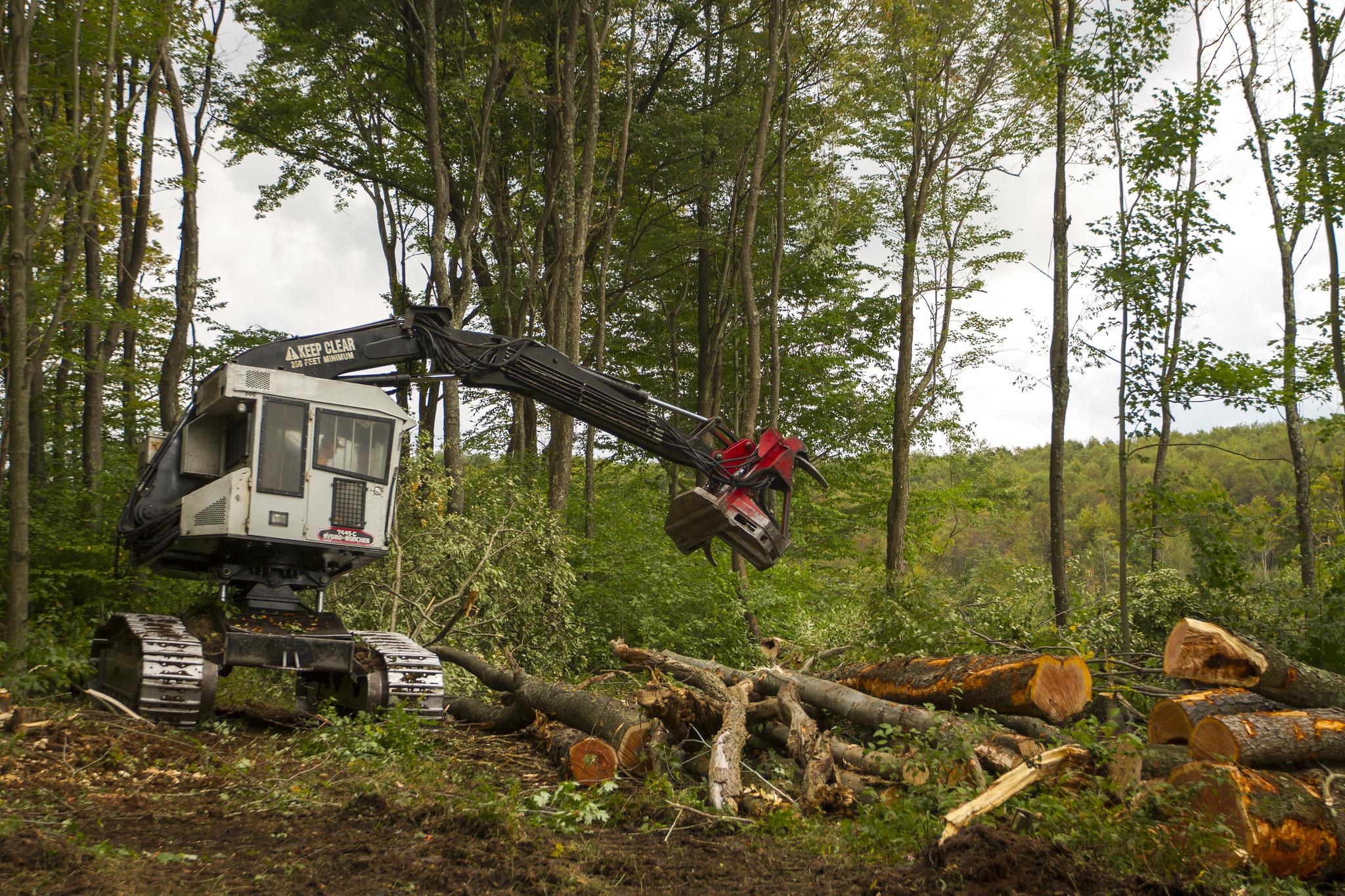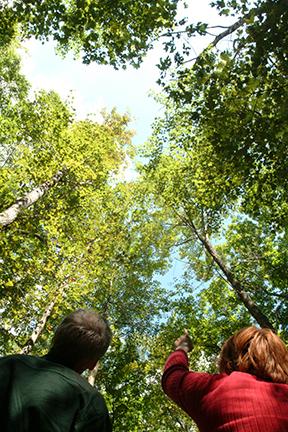The harvest of timber is something that most landowners only do once or twice in a lifetime. Whether or not the experience is a positive one will depend upon whether or not you use professional forestry assistance. Below are some common questions and concerns about harvesting timber in your woodland.

"U.S. Forestry: Luke Paper Mill and Woodlands Site" by World Resources is licensed under CC BY-NC-SA 2.0

Maryland "Call Before You Cut" program
Maryland participates in the "Call Before You Cut" program. The program provides land owners with state-specific tips and resources related to timber harvesting.
A misleading woodland harvest perception
Many landowners are sold a vision by some timber buyers, who claim that just a few trees will be removed. Unfortunately, poor harvesting choices result in a woodland that loses wildlife and other forest values for generations. For example, the use of diameter-limit cutting where trees over a certain diameter are cut fails to select trees on their individual attributes. The key to understanding what's best for your woodland is to ensure that all your questions are answered and that you work with a professional forester.
What to Avoid
Diameter Limit Cutting
This means trees are cut based on size, not on their ability to grow after harvesting. This type of harvest will usually limit the health and productivity of the next forest.
Selling Timber with No Contract
If you have no contract, your interests are not protected.
Being Paid as the Timber is Cut
Use lump-sum sales where you get all your money up front, and an acceptable contract, before any timber is cut.
Erosion and Sediment Control Problems
The landowner has final responsibility for ensuring that all local and state regulations are met. Violations can result in stiff fines.
Types of foresters

Maryland is one of the few states in this region that requires licensing to be considered a Maryland Professional Forester. The forester has a number and stamp. To be licensed the forester must have a 4-year forestry degree, experience, and acquire 8 continuing education credits every two years.
Public Forester: County-based forester who work for the state. They develop forest stewardship plans but will not handle commercial timber sales.
Consultant Forester: An Independent forester hired by you, who works as your agent to represent your interests and who works on commission or fee basis. The Consultant forester offers a broad range of services related to marketing timber, developing forest stewardship plans, and other services. Since this person represents your interests and is paid on commission, it is important that you feel comfortable with his or her decisions on your behalf. Interview a few consultants or get references from other forest landowners before you make a decision.
Industrial Forester: Forester who works for a particular mill and represents the interests of that mill.
Benefits of using a professional consultant forester
-
Better Job Environmentally - A contract is used to assure protection of the resources. The forester checks regularly on the harvesting to protect your interests.
-
Individual Trees are Marked - Trees in the sale area are marked and tallied by type, size and product. This is the basis of the bid notice sent to potential buyers in the area. You know what will be cut before the harvest and you can better visualize what it will look like.
-
More Income - Stumpage is sold on a competitive bid process. Sealed bids are solicited by interested buyers and you and the consultant forester can select the one you want. The offers for the same trees will vary widely depending on the timber markets in the area and the needs of different buyers.
Common questions about timber harvesting
"Isn't leaving my woodlands alone the best for wildlife and tree growth?"
Not necessarily...
Leaving your woodlands alone may not produce optimal wildlife habitat. Most forms of wildlife require varied types and ages of vegetation for food and shelter. In an unmanaged forest, overcrowding often retards tree growth, makes forests more susceptible to disease and insect damage, and reduces the diversity of wildlife habitats. Selective thinning provides more growing space and nutrients for desirable trees, which, in turn, reduces the stress and improves forest health. Other management techniques can be used to create needed wildlife habitat diversity. Why harvest forest products? The planting and harvest of trees is not only a way to receive some income from your property, but is also a major opportunity to improve wildlife habitat, access for recreation, and other forest benefits. However, this requires careful planning and objectives.
"Does managing my woodlands take a lot of money and time?"
No.
Improving your woodlands can actually increase your income while maintaining the environmental integrity of the landscape. Careful selection of your firewood or timber can increase the value of your woodland for wildlife, timber resources, recreation and other forest benefits, while providing income. These harvest assets can be used to build roads, improve wildlife habitats, or implement other practices that would not be otherwise affordable. Improving your woodlands does not need to take much of your time either. State foresters and wildlife biologists, as well as private consulting foresters, are available to help you develop and implement a forest stewardship plan. These professionals can assist you in enlisting the services of reputable logging operators to implement the plan. In this way, you can achieve your financial goals and enhance your woodlands.
"Careful management is a good idea, but aren't my woodlands too small for harvesting?"
No.
Woodland areas of any size can be managed to improve wildlife habitat and tree growth. Through careful management, even small parcels of land can be maintained as scenic areas and also provide favorable conditions for wildlife. In many cases, owners of adjacent property can work together to improve management and reach shared goals.
Common mistakes made by landowners
Timing is important when considering a timber harvest. Landowners often choose to harvest timber that is too small or wait too long to harvest. Having a forest stewardship plan prior to any harvesting decision ensures that you know what harvesting opportunities exist and the impact of those decisions.
Common concerns about timber harvesting expressed by landowners
"Timber harvesting is unsightly."
This can be minimized by having a sales contract that requires tree tops be cut close to the ground and using firewood or pulp markets to clean up slash left from the harvest of larger trees.
"The forest is damaged forever."
Using a licensed consultant forester to administer the sale and market the trees will usually take care of this problem. Avoid harvesting methods such as diameter-limit cutting that cut trees based on diameter rather than their individual attributes.
"The trees left will be damaged."
Hiring a licensed consultant forester will reduce the chances of this occurring. By working with the logging contractor, the remaining trees will be affected as little as possible.
"The harvest will create new roads that will ruin the area."
During the harvest process roads and log landings can be rutted and muddy, but most consultant foresters will require a performance bond from the logging contractor that is returned only after all the road are properly graded and seeded. Forestry Best Management Practices apply as well that all logging contractors must follow.
Where To Get Help

* The sale of timber products should include three people: 1) the forest landowner selling the timber; 2) a licensed professional forester to assist the landowner in determining which trees should be harvested and working with the logger; and 3) the logger who carries out the actual harvesting of the trees.
* A list of licensed professional foresters is available here.
* Call your state forester or Maryland Department of Natural Resources Forest Service at 410-260-8531
* In Delaware, call the Delaware Forest Service at 302-739-4811.
* For more information write or call the University of Maryland Extension's Wye Research and Education Center, P.O. Box 169, Queenstown, MD 21658 / 410-827-8056 or Western Maryland Research and Education Center, 18330 Keedysville Road, Keedysville, MD 21756 / 301-432-2767.
* Penn State Cooperative Extension provides a stumpage price report that would assist property owners in counties that border Pennsylvania.